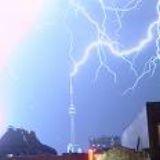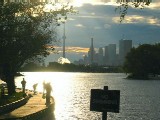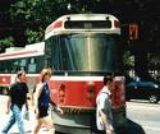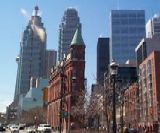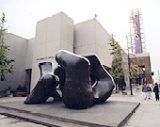 |
| Traveling
to Toronto |
|
|
Getting
Here
Located
on the northwestern shore of Lake Ontario, farther south than
Minnesota and much of Michigan, Toronto is one of the most
accessible cities in North America by road, air, rail. We
are only a one hour drive away for about five million Canadians,
and within a 90-minute flight for 60 per cent of the U.S.
population.
As
of June 1, 2009, everyone from every country that comes
to Canada by
air, land and sea needs a passport or equivalent travel document.
Permanent residents (who are not citizens) need their alien-registration
card and passport. (Some exceptions apply to children's passport
requirements)
http://gocanada.about.com/od/canadatraveloverview/qt/uscitizenborder.htm
Citizens
from all countries other than the US must have a valid passport,
and in some cases a visitor visa may be required.
Customs
Information
Canadian customs regulations apply for all personal and business
travel into Canada. For most travelers, they may clear customs
with their personal goods and belongings at the airport in Toronto.
Please check your local customs regulations if you are planning
on taking Canadian purchases home with you.
Toronto
City Centre Airport
Located on the western tip of a series of islands in Toronto
Harbour, the island airport handles scheduled, private and corporate
flights. Major airlines operating from the island include Air
Ontario, Trans Capital Airlines and Grand Aviation. Call 416-203-6942.
Air
Canada and many US and international carriers provide direct
flights to Toronto's Lester B. Pearson International Airport
(YYZ) from major cities in North and South America, Europe,
the Orient, and the Pacific Rim. Lester B. Pearson International
Airport is located just west of the city, the airport is accessible
from highways 401, 427 and 409. You can check the status of
your flight schedule here.
Transporation
From the Airport
The downtown Toronto hotels are approximately 13 km (8 miles)
from Lester B. Pearson International Airport.
Bus
service to and from Airport by Public Tansit
The TTC, Toronto's public transit, also provides Airport
Service and is the least expensive method of getting
to and from downtown Toronto.
Here's bus service from the Airport to TTC Kipling Station
take "192 Airport Rocket"
Service all day, every day, between Kipling Station and
Pearson Airport.
Provides fully-accessible bus service. Buses stop only at
Kipling station, Terminal 3 (Arrivals Level), and Terminal
2 (Arrivals Level). Ask a transportation officer fo rthe
location of the bus stop.
Service operates from approximately 5:30 a.m. to 12:30 a.m.,
seven days a week. One-way travel time to the subway is
approx. 20 minutes.
The closest subway station to Fields is 'Spadina' , at the
Spadina Station take the street car South to College Street.
Fields is east on College at 222 College Street.
See this link for maps and schedules: http://www.city.toronto.on.ca/ttc/service_to_airport.htm
By
Limousine/Taxi: Limousines are marginally cheaper than
taxis for the trip downtown. Both the Taxis and the Limousines
can be located immediately outside any airport terminal
on the Arrivals Level. You can reserve a Limousine by:
Airport Services (1-800-263-6135)
Air Flight Services (1-800-268-6843)
The trip downtown could take from 30 minutes to 1.5 hours
The fixed-rate taxi/limo fares to downtown are about CAD$50
to Fields.
By
the Airport Express Bus: The airporter bus travels from
the airport to the Delta Chelsea hotel. From there you can
transfer to the Mid-Town connector or a taxi which will
take you to the University of Toronto campus, Victoria University,
Massey College and the Quality Hotel on Bloor. Kiosks are
located outside any airport terminal on the Arrivals level.
(Terminal #1-Post #7; Terminal #2-Post #7; Terminal #3-Post
#29). The tickets cost $12.50 one-way or $21.50 return.
These buses will take at least 50 minutes to get downtown,
depending on traffic. In order to transfer to the Public
Transportation Subway System (locally known as the TTC)
you can take the Airport Express to Islington Station.
See: http://www.torontoairportexpress.com/
Arriving
by Car
Whether
approaching Toronto by car or by bus, the traveller will reach
Toronto by one of several major routes paralleling the shore
of Lake Ontario. Highways 401 and 2, and the Queen Elizabeth
Way, enter Toronto from the west. Highways 401 and 2 also enter
Toronto from the east. Hwy 400 runs from the north and connects
with Hwy 401. Major bus routes converge in Toronto. Out-of-town
buses arrive and depart from the Bus Terminal, located at 610
Bay St. Service to/from points all over Ontario, Canada and
the U.S. National and regional bus lines serve the Greater Toronto
area. Call (416) 393-7911 for bus company fares and schedules.
Toronto
is served by the VIA Rail System,
the network that provides all rail service throughout Canada
(with connections to the Amtrak system through Niagara Falls,
New York). Trains arrive at Union Station in downtown Toronto.Union
Station is located on Front Street, between Bay and University
(across the street from the Royal York Hotel). The station is
right on Toronto's subway line ( locally known as the TTC),
and is within walking distance of Rogers
Centre,the CN Tower,
the financial district and many downtown hotels, shops and restaurants.
There are also taxis available outside Union Station
Buses arrive at the downtown Toronto Bus Terminal at Bay and
Dundas. You can connect directly with the Public Transportation
Subway System (locally known as the TTC) and travel to your
hotel. There are also taxis available outside the Bus Terminal.
Money
may be exchanged at a favorable rate at Banks and Hotels.Shops
and restaurants will often accept U.S. currency, but at
a less favorable exchange rate.
To
convert your local currency to our Canadian Dollar,
try the Universal Currency
Converter
Sales
Taxes and Visitor Tax Refund
Most
items in Ontario, except food, are subject to both a 8% Provincial
Sales Tax (PST) and a 7% federal Goods and Services Tax (GST).
Non-residents of Canada, however, may claim a rebate for the
GST paid on accommodation and most consumer goods taken out
of the country. The GST Rebate Guide for Visitors, which includes
the rebate form, will be supplied in the registration package.
Please ensure that you retain all your receipts so that you
can claim your rebate at a Duty Free Shop as you leave the country.
|
|

